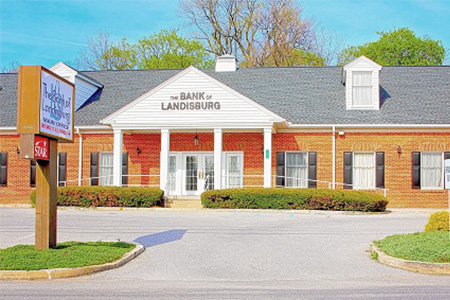Meeting the Needs of Customers at Asian Bank
Keeping the lines of communication open with customers was critical for community banks in responding to the challenges created by the pandemic.
“We knew the community, we knew the people, and we were small enough to make changes quickly,” said James Wang, president and chief executive officer of Asian Bank.
Despite the pandemic’s restrictions, Asian Bank’s customers preferred to discuss their questions in person or over the phone, said Wang. At first, the bank was open only a few hours every other day, but it was clear the clients needed more. So, practicing social distancing, customers waited in lines outside branch offices to speak with staff in person.

to customers and made changes to
respond to their needs during the
pandemic. Photo courtesy of Asian
Bank.
One of the biggest customer requests was waiving late fees. In response, Wang and his team moved the late fee date from the 15th to the 25th of each month, a policy that continued into the first quarter of 2021. “We wanted to make sure our customers were not incurring expenses for things beyond their control,” he said.
Wang and his management team met often to explore additional financial options for customers. One such solution was a Special Loan Program for customers in need. “We could lend enough working capital to borrowers to cover three to six months of loan payments so they wouldn’t be late on their payments,” said Wang. “We notified all of our customers about the program and provided details.” By the second quarter of 2021 when the program ended, the program had accommodated more than a quarter of the bank’s clients.
The special loan and forbearance programs worked well for the bank and its customers. “By March 2021, many clients had returned to making to regular payments on time,” said Wang.
Our customers felt they could trust us through the process, and we hold that with pride.
James Wang
President and Chief Executive Officer,
Asian Bank
Other customers needed assistance applying for the Paycheck Protection Program (PPP). But it was more than just processing loans; branch staff helped with the paperwork and provided translation support for customers whose first language was not English. “Our customers felt they could trust us through the process, and we hold that with pride,” Wang said.

community banks in our region to
offer guidance and support.
Guidance from the Philadelphia Fed was welcomed. “During the pandemic, the Fed made their presence known and their support available,” said Wang. This was especially true when Wang was considering the Special Loan Program. He reached out to Bill Spaniel and Bill Wisser in the Philadelphia Fed’s Supervision, Regulation, and Credit Department and reviewed all the program details.
As for recovery? This is a special concern for customers at Asian Bank who depend on visitors to frequent their Chinatown neighborhood restaurants and shops.
“So much of our recovery depends on the speed with which small businesses can regain their foot traffic to get back to ‘normal,’” said Wang. “It will take some time, but we’re here to help.”
Innovations at Fleetwood Bank
Timothy Snyder, president and chief executive officer of Fleetwood Bank and a member of the board of directors at the Philadelphia Fed, remembered the uncertainty the pandemic initially created for banks and customers. At the onset of the pandemic, with all eight branches closed, his staff set up shop on picnic tables in front of branch buildings to meet with customers, process loan applications, and answer questions.

was key in serving their clients’ needs during the
pandemic. Sometimes this meant meeting on picnic tables
in front of bank branches. Photo courtesy of Fleetwood
Bank.
“We actually added our picnic table as an Outlook calendar reservation option,” said Snyder. “One time when we double-booked our picnic table, we moved over to the hood of the customer’s truck to sign the loan papers.”
Many customers were quick to ask about options to stay afloat during the pandemic. By 2021, Snyder said both the banking industry and its customers had more information about options to help people get back on track. The media had covered what customers could expect from a bank in terms of mortgage modifications and forbearance. And banks were trying to assess what accommodations could be made without causing customer delinquency or negative consequences on a bank’s balance sheet.
We took on a much more consultative approach, working with customers and noncustomers alike, to help them get caught up with mortgage payments.
Timothy Snyder
President and Chief Executive Officer,
Fleetwood Bank
“We took on a much more consultative approach, working with customers and noncustomers alike, to help them get caught up with mortgage payments,” said Snyder. “The needs were that much greater.”
Fleetwood experienced an uptick in mortgage applications, with a record of more than $30 million in originations in 2021. In addition, loan modifications had decreased from 7 percent of Fleetwood’s mortgage portfolio in April 2020 to zero by year’s end. In 2021, only one customer needed to skip a payment.
“Our delinquency rate is the lowest it has been in the six years I have been here,” he said. “Credit quality or asset quality has really been holding up during these two years of uncertainty.”
This is also true for many of the community bankers who shared their experiences with state banking associations. Snyder said he worked closely with these associations and credits their staff and membership with bringing bankers together to discuss next steps.

with community banks to offer
guidance, answer questions, and
share ideas.
Fleetwood Bank also relied on the Philadelphia Fed for guidance during this time of uncertainty. “The Philadelphia Fed was always available to us, and Bill Spaniel, senior vice president and chief lending officer at the Fed, frequently joined our weekly conference calls to answer questions and share ideas,” said Snyder.
Establishing a more stable working environment is a step in the right direction. “Right now, we’re looking at higher costs and limited availability of materials and workers,” said Snyder. “Customers who can’t get raw materials and/or qualified workers will have to shelve their projects,” which will ultimately have an impact on borrowing from a bank. The recovery process will take time.
What makes our bank special are the people who work there.
Timothy Snyder
President and Chief Executive Officer,
Fleetwood Bank
“What makes our bank special are the people who work there,” said Snyder. “We know the customers who walk in our doors, we know their businesses and their circumstances. This really helped open people’s eyes to the benefits of working with a community bank.”
Getting Back to “Normal” at the Bank of Landisburg
In 2021, the Bank of Landisburg ended the year on a high note after processing its share of deferments, mortgages, and PPP loans for customers. “We are pretty much back to where we were before the pandemic,” said Gerry Sheaffer, chief executive officer and executive vice president of the Bank of Landisburg.

support to its primarily agricultural customer base
through the pandemic. Photo courtesy of the Bank of
Landisburg.
Early on, customers were concerned about keeping their payments current if they were experiencing an impact from COVID, said Sheaffer. “They wanted to make sure they stayed in good standing with the institution and paid their bills on time. If they couldn’t, they wanted advice from us on what to do.”
Patti McLaughlin, chief credit officer at the bank, said requests for deferments rose to the top of the list for customers during the pandemic. “On the loan side, we offered a reprieve to our customers and still do,” she said. Initially, if a customer asked for a COVID deferment, the bank offered a one-month deferment, but customers usually asked for a three-month deferment that could be extended for six months. A total of 167 of the bank’s accounts received at least a one-month deferment in 2020 and 2021, she said.
The Bank of Landisburg also helped process a total of 158 PPP loans for its customers, and 60 of those loans were completed in 2021, said McLaughlin. She explained that much of the bank’s customer base is in agriculture, primarily in the dairy industry. “Many of our ag customers weren’t familiar with the program, so our individual outreach helped in deciding whether it was a good fit for them.”
During the first half of 2021, mortgage applications were on a record upswing, with lower rates and stimulus money driving residential and commercial activity. By the end of 2021, the Bank of Landisburg wasn’t dealing with forbearance delinquency. It was quite the opposite, according to Ray Egolf, president and chief administrative officer, who explained that overdrafts and delinquency rates hit all-time lows in 2021.
Lending remained consistent overall for the bank during the pandemic. “We didn’t really see much change from 2020 to 2021,” said Sheaffer, with 628 loans in 2020 and 673 in 2021. And the bank continued to process commercial loans in 2021. “We’re still seeing lots of activity with small businesses looking to buy a piece of equipment or helping a new restaurant open its door,” said McLaughlin.
“We’re pretty much back to normal,” said Sheaffer, “and we’re here as we have been all throughout the pandemic to help our customers with whatever they need.”
- The views expressed here are solely those of the author and do not necessarily reflect the views of the Federal Reserve Bank of Philadelphia or the Federal Reserve System.

